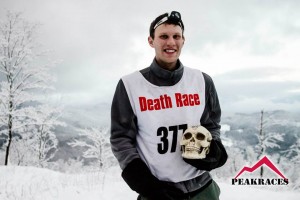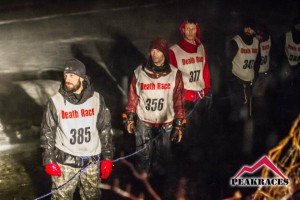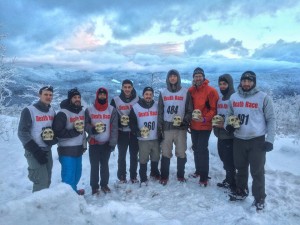 (Its curious how these interviews develop. A online transaction with Scott Gregor led to my discovering he’d finished third in a Death Race the previous month. The Death Race is a brutal non stop event in which people push their bodies and minds to the limit – in this case, over a long weekend in a Vermont January. While I’m not an athlete, I’m fascinated by everyday people who stretch and challenge themselves, and this event is a definite stretch. So I’m pleased Scott agreed to be interviewed.
(Its curious how these interviews develop. A online transaction with Scott Gregor led to my discovering he’d finished third in a Death Race the previous month. The Death Race is a brutal non stop event in which people push their bodies and minds to the limit – in this case, over a long weekend in a Vermont January. While I’m not an athlete, I’m fascinated by everyday people who stretch and challenge themselves, and this event is a definite stretch. So I’m pleased Scott agreed to be interviewed.
The Winter Death Race was held in Pittsfield, Vermont, over the weekend of January 16. Thirty competitors started, nine finished. A video description of the event can be found here.
The Death Race is run by Peak Races. Photos are used with the permission of Peak Races and Scott Gregor.)
Q: Scott, congratulations on your success in the Death Race. So our readers better understand how you succeeded in this event, lets start with some background questions. How old are you? Are you married, have children? What line of work are you in? I know you are not a professional athlete, but are you sponsored in some way?
SG: I am 28 years old and from CT. I am not married and I do not have any children. I work a 9-5 office job as a software engineer working on airplane engines. I am not sponsored.
Q: Do you have a history of athleticism? Of outdoor activity? What do you do when you aren’t doing death racing?
SG: I do not have much of a history of athleticism. I played sports for a few years growing up but, aside from baseball, I didn’t like them too much. I stopped playing baseball in high school and I played golf for a couple of years. I didn’t really like golf all that much either. I was also into skateboarding during high school and college, that was a lot of fun.
I was in the Cub Scouts when I was in elementary school but never followed through to the Boy Scouts. I used to go camping at Calvin Coolidge State Park in Vermont every year with my family. So I have a little bit of a history with outdoor activity.
I like to run, which is good training for the death race. I prefer trail running to road running. I like being in nature, the variety of terrain, and the sense of exploration that comes with trail running. My longest race to date was a 50 miler called Lookout Mountain in Chattanooga, Tennessee. I want to run a 100 miler one day.
Q: What is your experience in obstacle course racing? What drew you to it?
SG: I went to spectate someone at a Tough Mudder. He was about twice my age and I was amazed at his ability to run 10 miles on a mountain with obstacles. After I saw that, I wanted to do it too but I wasn’t in shape to do it. I was strong from weight lifting but I couldn’t run. I guess it was the allure of a challenge that drew me in. I knew I should start small and work my way up to 10 miles, so I looked for shorter obstacle course races.
I found out that Spartan race has short/medium/long distances (sprint/super/beast) so I started with the sprint. I wasn’t much of a runner at the time, but the feeling of running downhill through the woods, diving into water/mud, and doing the obstacles was so primal. I felt free and careless. I felt a sense of exploration that I haven’t felt in a long time.
After the Spartan sprint I was hooked. I like to push myself to something harder every time and not run the same distance twice. I ended up doing the following:
* Spartan race sprint
* Spartan race super
* Spartan race beast
* Tough mudder
* Bone frog challenge
* Spratan race hurricane heat
* Civilian military combine
* GORUCK challenge
* Spratan race 12 hour hurricane heat (DNF)
* Spartan race ultra beast
* Spartan death race (winter)
Q:What specifically enticed you to enter the winter death race you just finished?
SG: After I did the Spartan Sprint I went home and researched OCR. I wanted to know every race and its distance, since to me, progress was greater distance instead of running the same thing faster. I read about the 24 hr+ Death Race back in 2013. I couldn’t even fathom how a race this long could be humanly possible. I wondered about the people who did these seemingly impossible things.
I was toying with the idea of doing the Death Race in 2016 to allow myself a lot of time to train. I thought I’d do the team Death Race in 2015 as it would be easier to not quit if I had to be accountable to other people. Peak races announced that 2015 would be the last year of the Death Race and there would be no team Death Race. I ended up buying a package of 2015 winter/Mexico/summer Death Race. I guess I wanted to see if I could live up to what I imagined a Death Racer is.
Q: What sort of preparation did you go through for this event?
SG: My training mostly consisted of running. I followed Bryon Powell’s 40mi to 100km on 50 mi/wk ultra marathon plan. I run 5 days a week. On the two days I don’t run I lift weights to maintain upper body strength. My running plan called for a short run on Sunday, so I would also backpack for a few hours with 30-50 lbs after I finished my run.
I also went to the green mountain trails in Pittsfield, VT three times to learn the trails where the race would be. You’re not told exactly where the race will be, but this is where it had been in the past. This paid off when I once went to the wrong cabin during the race. I was able to bushwhack straight through the woods to the correct cabin instead of backtracking along a trail.
Q: You sent me a video explaining the event, and mentioned you were the guy who showed up without his gear. What happened? And when your gear arrived what did it consist of?
SG: Peak Races had sent out an email to racers that there would be a mandatory meeting Friday night at 9pm. If we didn’t attend, we couldn’t race. The email said the race would start before 6am on Saturday. The email also said we could bring any gear we wanted, so I only brought my drop bin to leave overnight so I’d have less to bring the next morning. I left my backpack with all the mandatory gear at home which was about 30 min away.
I showed up to the race and everyone else had all of their gear. I realized it was a trick and my parents went home to get my backpack with my gear. Luckily my drop bin had a pair of snow pants and boots so I was able to start the race. My parents dropped my backpack off and I was able to retrieve it maybe 5 hours into the event. I didn’t have any food or water for these first 5 hours. People would let me have a sip of water every now and then.
My missing gear included:
100 ft of rope, an axe, a knife, a 5 gallon bucket, construction ear muffs, a blind fold, head lamp, spare clothes/gloves/hat, food, and water.
Q: What were the high points of the death race? The low points?
SG: Not having my gear at the start was a low point. The event had just started and I was thinking I should probably just quit now. I was not prepared. I decided to just give it a go and hope that my gear arrives soon and that staff doesn’t torture me too bad for not having it.
Another low point was rolling down this little hill 50 times in 1 hour. Everybody felt so nauseous when we reached the bottom of the hill. We all felt like we were going to throw up but there wasn’t much food in us anyways. One guy did throw up and he kept going.
 My biggest low point was having to sit in the river for 59 minutes. As a group, we had to sit in the river up to about the bottom of our rib cages for 5 minutes. Staff made us do this just to see how terrible it is to have to sit in that river. It was night time, snowing, and VT route 100 right next us was shut down by the state. Right after I got out, I learned that I had to do 59 more minutes in the river as a penalty. I was out of dry clothes. I took off my bib and told a few people that I was going to quit. They convinced me to stay in and I learned that after the 59 minutes in the river there were only 335 burpees standing between me and the finish line. I did the 59 minutes in the water over 4 shifts which took about 4 hours total. I would come running back to the barn shaking uncontrollably and head to medical to get warmed up. I was told I was the biggest medical liability of the race. I wish I had brought a wetsuit like a few smarter people. It’s been a little over 3 weeks since the race and the feeling in my toes is still coming back.
My biggest low point was having to sit in the river for 59 minutes. As a group, we had to sit in the river up to about the bottom of our rib cages for 5 minutes. Staff made us do this just to see how terrible it is to have to sit in that river. It was night time, snowing, and VT route 100 right next us was shut down by the state. Right after I got out, I learned that I had to do 59 more minutes in the river as a penalty. I was out of dry clothes. I took off my bib and told a few people that I was going to quit. They convinced me to stay in and I learned that after the 59 minutes in the river there were only 335 burpees standing between me and the finish line. I did the 59 minutes in the water over 4 shifts which took about 4 hours total. I would come running back to the barn shaking uncontrollably and head to medical to get warmed up. I was told I was the biggest medical liability of the race. I wish I had brought a wetsuit like a few smarter people. It’s been a little over 3 weeks since the race and the feeling in my toes is still coming back.
Some of the high points were the view from the top of the mountain. The sky was really clear on the first night and we were able to see thousands of stars. We also had the finishing ceremony at sunrise on the summit after the snow storm had stopped. The view of pristine white mountains surrounding us was surreal.
This high point may sound silly but it was when a crew member for another racer gave me an orange. I had been eating only clif bars for a little over 24 hours straight. I was doing laps up and down the mountain which were 2 mi round trip and 2000 ft of elevation gain. I got a craving for fruit and when I got to the cabin at the base, I saw another racer eating grapes. I asked for some grapes and he gave me some, then someone else offered me an orange. They even peeled it for me. It was the best piece of fruit I’ve ever had.
Q: You’ve explained what enticed you to OCR events. What do you think is the reason or reasons for the surge in interest from the general public?
SG: I think that people are drawn to OCR since it is something new and different. It breaks up the monotony of running by including fun obstacles and it gives people a chance to challenge themselves. OCR also contains an element of exploration that is not seen in most other types of races.
Q: As you may have noticed, A Taste For The Woods stresses participation for everyone in the outdoors, athlete and non-athlete alike. Do you think athleticism is overstressed in discussing the outdoors? Not discussed enough? Can OCR in particular and athleticism in general be a way to get people active in the outdoors?
SG: A great thing about the outdoors is that anyone can enjoy being outdoors regardless of how athletic you are. Most of my time outdoors is focused on athletic events, but it doesn’t need to be this way for everyone. Being outside and being active is a great way to be happy and healthy, whether it is a casual hike or a long distance endurance event. I do think that OCR and athleticism are ways to get people more involved with the outdoors, but of course they are not the only way.
Q: Scott, thank you for sharing the story of your event, and good luck for the next Death Race!




